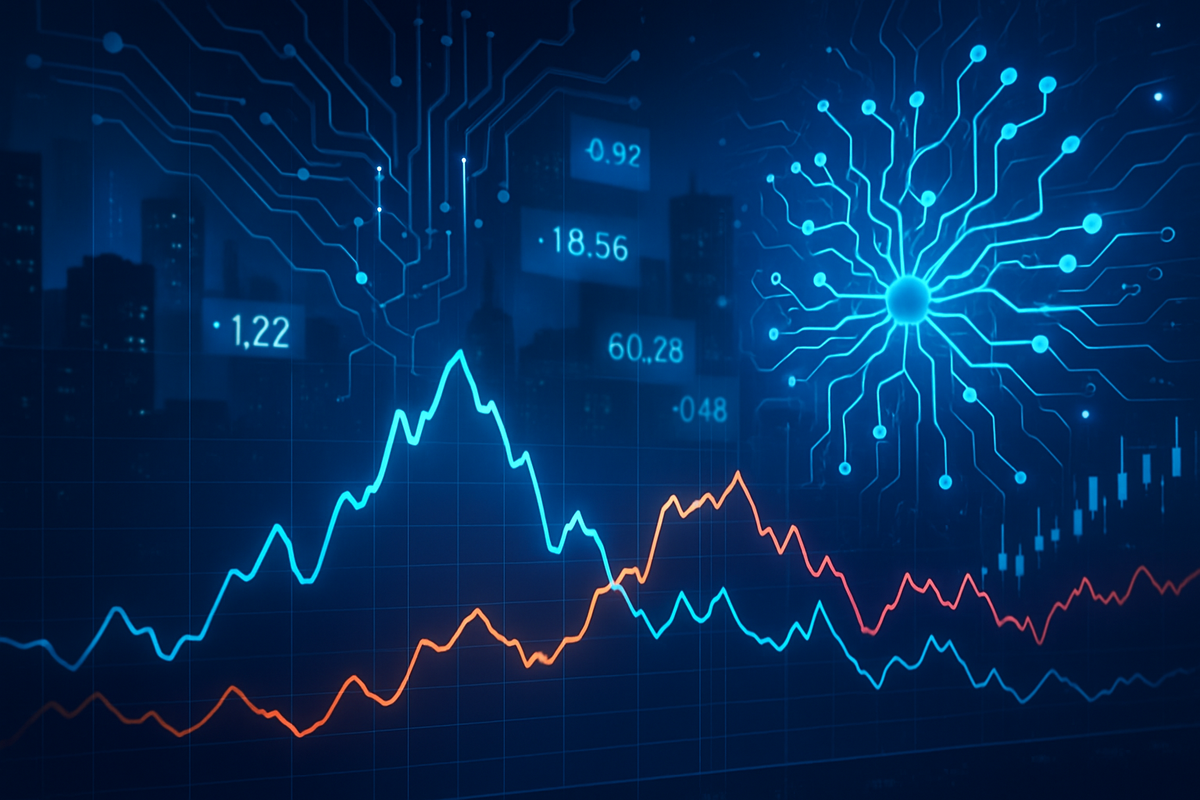
The financial markets are currently grappling with a fascinating dichotomy: a pronounced "sector churn" where investor interest appears to be rotating from traditional growth stocks towards more cyclical sectors, even as the artificial intelligence (AI) landscape continues its meteoric ascent. This dynamic has ignited a fervent debate among market experts and investors alike: are we witnessing the formation of an "AI bubble" reminiscent of past speculative frenzies, or is this simply a fundamental re-rating of companies poised to revolutionize industries? The answer carries significant implications for portfolio allocations and the broader economic outlook.
The Great Rotation: AI's Unyielding Ascent Amidst Shifting Tides
The current market narrative is largely defined by a significant shift in investor preference. For much of the past decade, growth stocks, particularly in technology, dominated returns. However, recent months have seen a noticeable rotation towards cyclical sectors such as industrials, materials, and financials. This "sector churn" suggests a belief that economic growth might be broadening beyond the tech-centric expansion of recent years, or perhaps a defensive move by investors seeking value in less volatile areas.
Despite this broader rotation, AI-related sectors continue to exhibit remarkable strength. The global AI market, valued at approximately $391 billion as of July 2025, is projected to skyrocket to $1.77 trillion by 2032, representing a staggering compound annual growth rate (CAGR) of 29.2%. This explosive growth is fueled by continuous technological advancements, insatiable demand across industries, and a boom in generative AI tools like ChatGPT and Large Language Models (LLMs). Governments worldwide are pouring billions into AI research and development, and enterprise AI adoption is accelerating, with roughly 35% of businesses already integrating AI into their operations. This sustained momentum in AI, even as other sectors ebb and flow, is a key factor driving the "AI bubble" debate.
The AI Gold Rush: Winners, Losers, and the Concentration of Wealth
The AI revolution, while promising widespread benefits, is also creating a distinct set of winners and losers in the market, leading to a significant concentration of gains in a few mega-cap technology companies.
At the forefront of the AI boom are the "Magnificent Seven" mega-cap technology companies: Nvidia (NASDAQ: NVDA), Microsoft (NASDAQ: MSFT), Alphabet (NASDAQ: GOOGL), Amazon (NASDAQ: AMZN), Meta Platforms (NASDAQ: META), Apple (NASDAQ: AAPL), and Tesla (NASDAQ: TSLA). These giants, collectively representing approximately one-third of the S&P 500's market capitalization, have driven much of the market's recent growth. Nvidia, often dubbed the "undisputed king of AI hardware," dominates the data center GPU market, with an estimated 92% share in 2024, making its GPUs essential for training complex AI models. Microsoft has solidified its AI platform leadership through its strategic partnership with OpenAI and the integration of AI into its Azure cloud services. Amazon Web Services (AWS) is rapidly gaining ground in foundational AI models with its Bedrock service, leveraging its extensive cloud infrastructure.
Beyond these tech titans, "picks and shovels" providers like DuPont (NYSE: DD), supplying materials for data center construction, and Caterpillar (NYSE: CAT), providing heavy equipment, are also benefiting. Industries across the board, including healthcare, finance, law, manufacturing, and retail, are rapidly adopting AI to enhance operations and gain a competitive edge.
However, the AI boom also presents significant challenges. Companies that delay AI implementation risk falling behind, struggling with siloed data, archaic IT systems, and a lack of technical talent. Small-cap technology companies, in particular, are finding it difficult to compete with the hundreds of billions of dollars in AI infrastructure investment from the "Magnificent Seven," leading to a widening performance gap. Furthermore, industries with tasks highly susceptible to automation, such as customer service and certain programming roles, face potential job displacement. Even within the hardware sector, some companies face setbacks; Samsung (KRX: 005930) made a critical misstep in the high-bandwidth memory (HBM) sector, allowing rival SK Hynix (KRX: 000660) to secure a major contract with Nvidia, impacting Samsung's profits.
Echoes of the Past: Industry Impact and Broader Implications
The current AI-driven market dynamics bear striking resemblances to past market phenomena, raising questions about broader industry trends, potential ripple effects, and regulatory considerations.
The AI boom is not merely a technological phenomenon but a fundamental economic shift, profoundly influencing existing industry trends. It's seen as a major engine for productivity and economic growth, capable of doubling annual global economic growth rates by 2035. This acceleration of digital transformation is evident across sectors, from healthcare and manufacturing to finance and entertainment, where AI-powered systems are generating significant revenue. The boom is also intrinsically linked to the data-driven economy, leveraging vast data availability and the Internet of Things (IoT) to fuel its capabilities.
However, this rapid ascent also creates intense competition. Companies that lag in AI adoption risk a significant competitive disadvantage. The dominance of hyperscale companies like Microsoft, Google (NASDAQ: GOOG), Amazon, and Nvidia, who are investing hundreds of billions in AI infrastructure, raises concerns about market concentration and their potential influence over the future of AI. Despite this, the AI ecosystem remains "wildly competitive," with the rise of open-source AI models challenging proprietary systems and fostering global innovation.
The powerful impact of AI has brought regulatory and policy implications to the forefront. Ethical concerns, particularly the potential for social bias in AI systems and the misuse of private data, are paramount. Policymakers are also scrutinizing the potential for job displacement and the broader societal impacts, including the spread of misinformation. Different countries are adopting varied approaches to AI regulation, with the European Union's AI Act setting a precedent for comprehensive AI law. Regulators face the delicate balance of fostering innovation while ensuring safety and accountability.
Historically, the current AI boom draws comparisons to the speculative enthusiasm of the dot-com bubble in the late 1990s and the telecom boom that followed. These periods were marked by rapid technological advancements and speculative investments, raising concerns about potential market corrections if investment outpaces clear revenue growth. More broadly, the AI boom is likened to the Industrial Revolution and the invention of the printing press, both of which fundamentally altered societies and economies, underscoring AI's potential for massive social, economic, and cultural change.
The Road Ahead: Navigating the AI Frontier
The trajectory of the AI market and its broader implications for the economy remain a subject of intense speculation and strategic planning. Both short-term volatility and long-term transformative potential are on the horizon.
In the short term (next 1-5 years), generative AI will continue to be a major focus, transforming creative and enterprise applications. Its use cases will extend from marketing content to code generation and knowledge-based augmentation. AI will also deepen its integration into various sectors, including healthcare (precision medicine, drug development), finance (fraud detection, customer service automation), and manufacturing (predictive maintenance, quality control). The emergence of early forms of "agentic AI systems," capable of proactively pursuing goals, will also be a significant development.
Looking further ahead (beyond 5 years), AI is expected to become an integral part of daily life and business, with agentic AI systems managing everything from business workflows to smart homes. AI is projected to add trillions to the global economy, with McKinsey research sizing the long-term opportunity at $4.4 trillion in added productivity growth potential from corporate use cases. The resolution of current AI limitations could bring society closer to Artificial General Intelligence (AGI), where systems can perform high-skill jobs like law and medicine. While some jobs will be displaced, AI is also expected to create new job types focusing on uniquely human skills like creativity and empathy.
To navigate this evolving landscape, businesses must pivot from a "use case" mindset to a "business imperative" mindset, redesigning core functions with AI to drive customer acquisition, product innovation, and organizational efficiencies. Significant investment in workforce reskilling and upskilling will be crucial to foster human-AI collaboration. Strategic investment in AI and high-performance computing (HPC) infrastructure, along with cultivating a data-driven culture, will also be essential.
However, significant challenges remain. Ethical concerns, including algorithmic bias and data privacy, will require continuous attention. A global shortage of skilled AI professionals continues to outpace supply, posing a barrier to adoption. High development and deployment costs, particularly for small and medium-sized enterprises (SMEs), and the potential for job displacement will also need to be addressed through policy and societal adaptation. The reliance on vast quantities of human-generated data for training large AI models is leading to concerns about data scarcity and the risk of "model collapse" from synthetic data.
The future of AI could unfold in several scenarios: incremental adoption leading to widespread productivity gains, transformative change that fundamentally reshapes industries and creates new ones, or an uneven distribution of benefits leading to widening divides and potential public distrust if ethical concerns and job displacement are not adequately managed.
Conclusion: A Transformative Era Demands Vigilance
The current market environment, characterized by sector churn and the undeniable ascent of AI, represents a transformative era for financial markets and the global economy. The "AI bubble" debate, while valid, should not overshadow the profound and lasting impact that artificial intelligence is poised to have.
The concentration of gains in a few mega-cap technology companies highlights the winner-take-most dynamics of this technological revolution. While these companies are driving innovation and significant market returns, it also raises questions about market breadth and potential systemic risks. The historical parallels to past speculative bubbles serve as a crucial reminder for investors to exercise caution and conduct thorough due diligence.
Moving forward, investors should closely watch several key indicators. The pace of AI adoption across various industries, beyond the initial tech giants, will be critical. Regulatory developments, particularly concerning data privacy, ethical AI, and potential antitrust measures, will significantly shape the landscape. Furthermore, the ability of companies to effectively integrate AI into their core operations and demonstrate tangible returns on investment will differentiate long-term winners from those caught in the hype cycle. The AI revolution is here, and while its path may be volatile, its long-term impact on productivity, innovation, and societal change is undeniable. Navigating this complex terrain will require both strategic foresight and a keen understanding of the underlying technological and economic forces at play.






